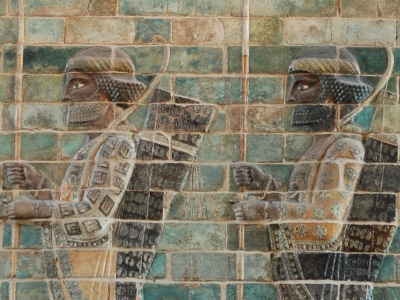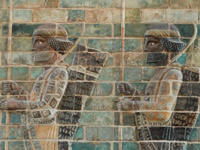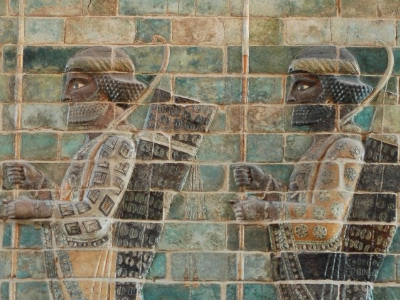Battle of Marathon (490 BC)

Aftermath
In the immediate aftermath of the battle, Herodotus says that the Persian fleet sailed around Cape Sounion to attack Athens directly. The Athenians evidently realised that their city was still under threat, and marched as quickly as possible back to Athens. The two tribes which had been in the centre of the Athenian line stayed to guard the battlefield under the command of Aristides. The Athenians arrived in time to prevent the Persians from securing a landing, and seeing that the opportunity was lost, the Persians turned about and returned to Asia. Connected with this episode, Herodotus recounts a rumour that this manoeuver by the Persians had been planned in conjunction with the Alcmaeonids, the prominent Athenian aristocratic family, and that a "shield-signal" had been given after the battle. Although many interpretations of this have been offered, it is impossible to tell whether this was true, and if so, what exactly the signal meant. On the next day, the Spartan army arrived at Marathon, having covered the 220 kilometers (140 mi) in only three days. The Spartans toured the battlefield at Marathon, and agreed that the Athenians had won a great victory.
The Athenian and Plataean dead of Marathon were buried on the battlefield in two tumuli. On the tomb of the Athenians this epigram composed by Simonides was written:
Ἑλλήνων προμαχοῦντες Ἀθηναῖοι Μαραθῶνι
χρυσοφόρων Μήδων ἐστόρεσαν δύναμιν
Fighting at the forefront of the Greeks, the Athenians at Marathon
laid low the army of the gilded Medes.
In the meanwhile, Darius began raising a huge new army with which he meant to completely subjugate Greece; however, in 486 BC, his Egyptian subjects revolted, indefinitely postponing any Greek expedition. Darius then died whilst preparing to march on Egypt, and the throne of Persia passed to his son Xerxes I. Xerxes crushed the Egyptian revolt, and very quickly restarted the preparations for the invasion of Greece. The epic second Persian invasion of Greece finally began in 480 BC, and the Persians met with initial success at the battles of Thermopylae and Artemisium. However, defeat at the Battle of Salamis would be the turning point in the campaign, and the next year the expedition was ended by the decisive Greek victory at the Battle of Plataea.
Conclusions
There are several explanations of the Greek success. Most scholars believe that the Greeks had better equipment and used superior tactics. According to Herodotus, the Greeks were better equipped. They did not use bronze upper body armour at this time, but that of leather or linen. The phalanx formation proved successful, because the hoplites had a long tradition in hand-to-hand combat, whereas the Persian soldiers were accustomed to a very different kind of conflict. At Marathon, the Athenians thinned their centre in order to make their army equal in length to the Persian army, not as a result of a tactical planning. It seems that the Persian centre tried to return, realizing that their wings had broken, and was caught in the flanks by the victorious Greek wings. Lazenby (1993) believes that the ultimate reason for the Greek success was the courage the Greeks displayed:
Marathon was won because ordinary, amateur soldiers found the courage to break into a trot when the arrows begun to fall, instead of grinding to a halt, and when surprisingly the enemy wings fled, not to take the easy way out and follow them, but to stop and somehow come to the aid of the hard pressured centre.
HISTORY

RESOURCES
This article uses material from the Wikipedia article "Battle of Marathon (490 BC)", which is released under the Creative Commons Attribution-Share-Alike License 3.0.
© Stories Preschool. All Rights Reserved.









